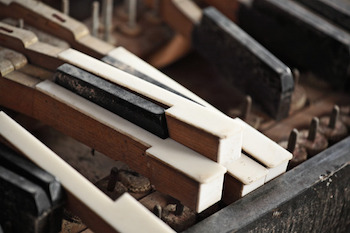If you have a piano, and have played for any length of time, chances are you’ve experienced sticking piano keys. They play fine, until one day you press down a key and its sluggish, and simply won’t make a sound. There are a lot of reasons this can happen, including:
- Jamming parts

- Broken action
- Food or other particles between the keys
- Warped keys rubbing together
- Broken keys
- Excessive moisture
One of the most common reasons a key will stick, causing a note to not make a sound when pressed, is moisture within the action. A key is guided in its up and down motion by two metal pins, a balance pin and a guide pin. Both pins are extended up into the key channels through a thin felt bushing cloth.
The guide pin can be the problem, especially if the piano resides in humid conditions. Even a small amount of moisture trapped in the bushing can cause the felt to swell, and cause it to grip the pin too tightly. The result is a sticking key, or a key that fails to return to its normal position after being depressed. This is also a frequent problem with new pianos, as the bushings are made to fit tightly, and it may take time to allow the felt to wear down and compress. The pin can be freed by working the pin through the bushing a few times in order to open up the space. Work the key up and down using moderate pressure to compress the felt bushing.
Another easy to fix problem, especially with new pianos, is an out of position keyslip. The keyslip is a thin strip of wood located in front of the keys. The distance between the keys and the keyslip is an eighth of an inch or less. If moisture or swelling impacts the keyslip, it can easily rub against the keys, causing them to stick. Sometimes you can gently work the keyslip back into position with your fingertips, pulling towards you. If the keyslip is warped, it may need replacing.
If the problem isn’t easily fixed, and you continue to have problems with sticking, its time to call in a reputable tuner to fix your keys and bring them back to playing condition.

